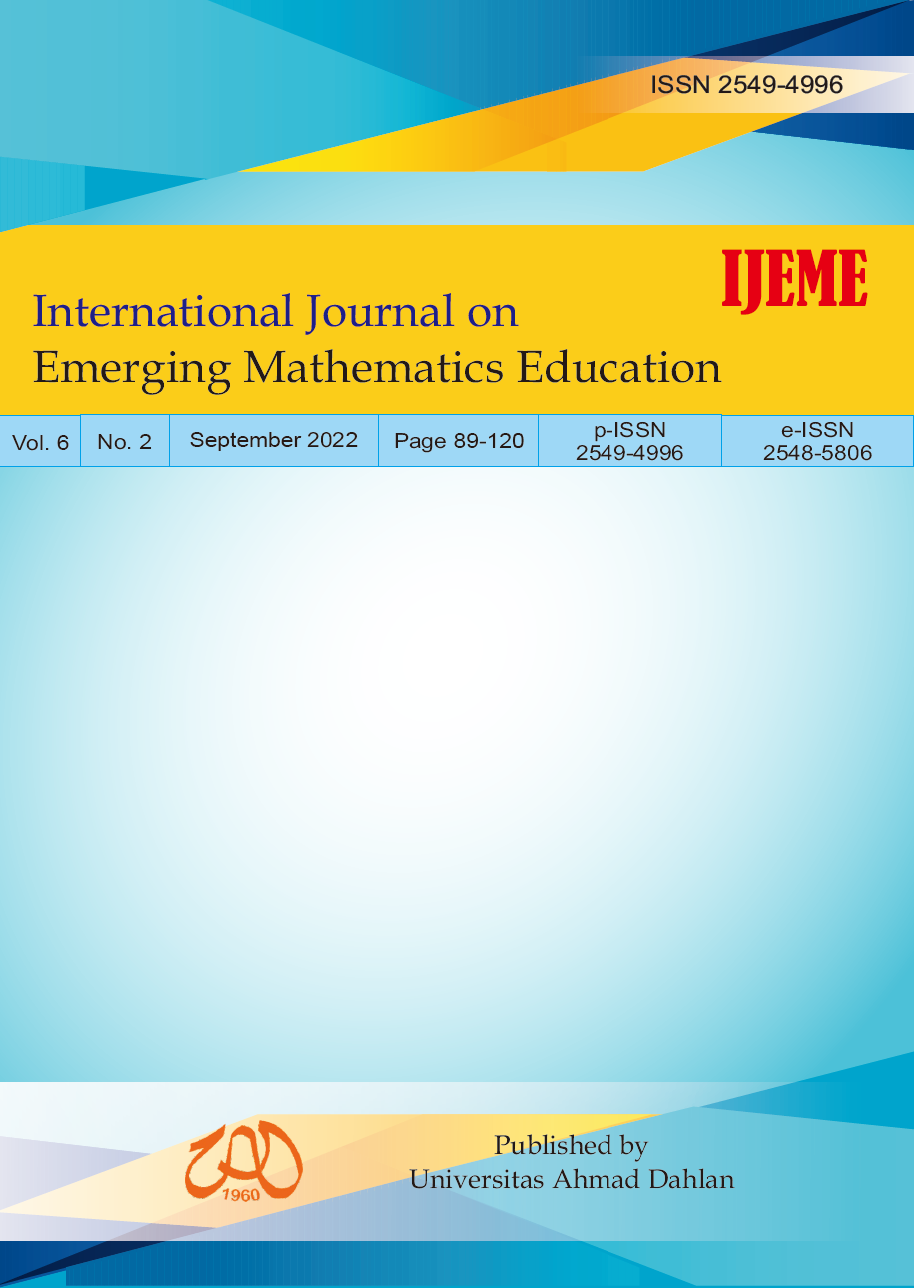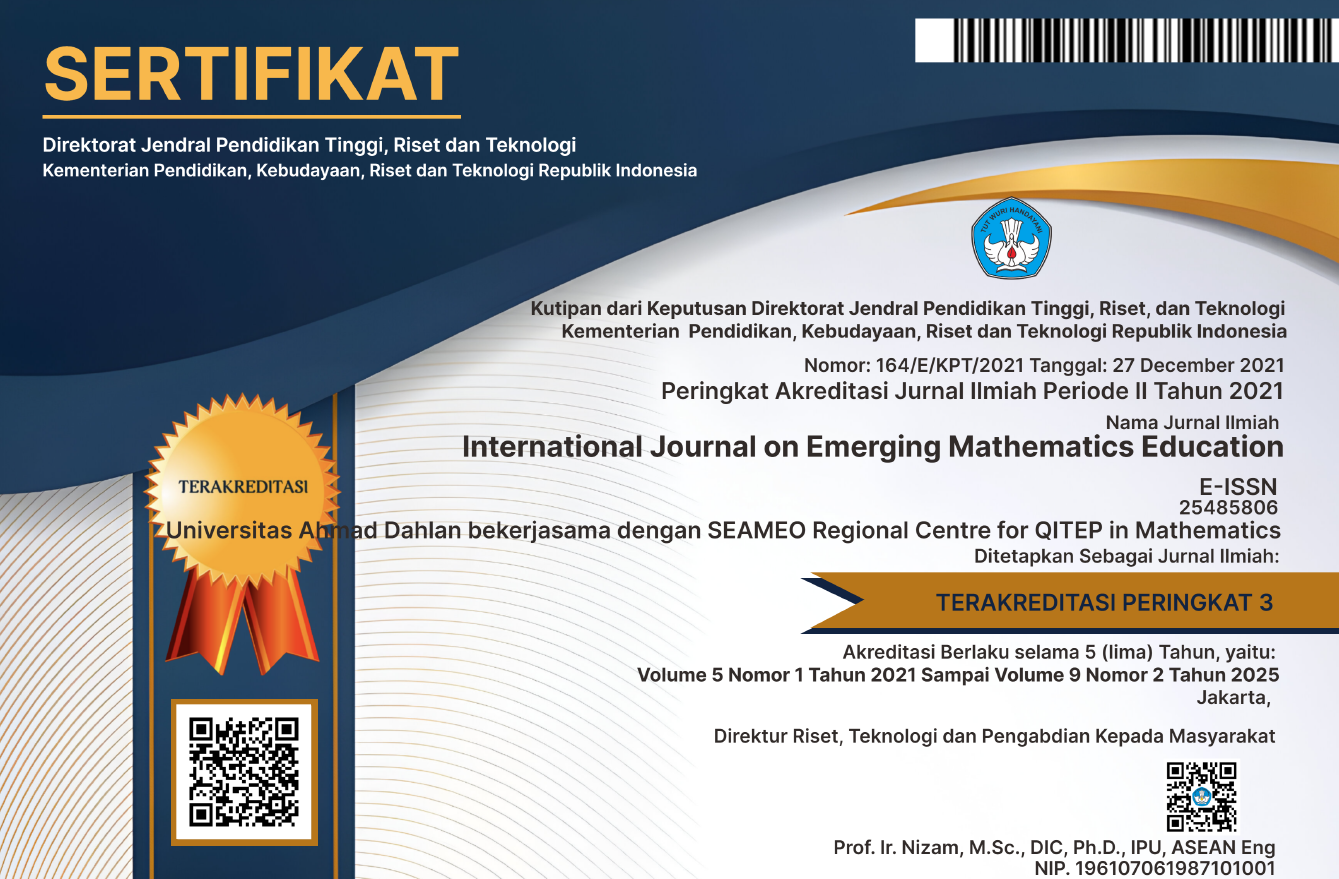STEM Highlights: Principles, Frameworks and Implementation Strategies in Improving Scientific Literacy
DOI:
https://doi.org/10.12928/ijeme.v6i2.19812Keywords:
Literature study, Scientific literacy, STEMAbstract
The 21st-century era, marked by the rapid development of information technology, requires students to be adaptive and have several skills that must be mastered to be able to compete in today's era. The important skills in the 21st century or so-called The 4C-skills consist of communication, collaboration, critical thinking, in general containing specific skills that need to be empowered in learning activities, such as problem-solving skills, critical thinking, communication skills, collaborating, innovation and creation, literacy, information metacognition, and various other skills. However, the reality in the field is based on the results of TIMSS and PISA, where this test measures the mathematics, science, and literacy skills of developed and developing countries, Indonesia's ranking is still in the lowest rank. The method used in this research is the literature study method, which examines the STEM principles, implementation strategies, and their prospects for improving scientific literacy skills. Based on the results, the success key while implementing STEM in the classroom is to prepare STEM educators with a conceptual understanding of the principles, frameworks, and strategies of integrated STEM implementation and learning theories from the four STEM fields. It should be integrated to increase the pedagogical skills and to mastery the technology as a learning support. Also, the development of professional experience for teachers in implementing STEM in various cross-materials is needed to provide a strong conceptual framework of an integrated STEM approach and build their confidence in teaching an integrated STEM approach. Hopefully, this article can provide a comprehensive overview of improving scientific literacy as one of the keys to improving the quality of quality education in Indonesia.
References
Afriana, J., Permanasari, A., & Fitriani, A. (2016). Penerapan project based learning terintegrasi STEM untuk meningkatkan literasi sains siswa ditinjau dari gender. Jurnal inovasi pendidikan IPA, 2(2), 202-212.
Akaygun, S., & Aslan-Tutak, F. (2016). STEM Images Revealing STEM Conceptions of Pre-Service Chemistry and Mathematics Teachers. International Journal of Education in Mathematics, Science and Technology, 4(1), 56-71.
Alatas, F., & Yakin, N. A. (2021). The Effect of Science, Technology, Engineering, and Mathematics (STEM) Learning on Students’ Problem Solving Skill. JIPF (Jurnal Ilmu Pendidikan Fisika), 6(1), 1-9.
Bereiter, C. (1992). Referent-centred and problem-centred knowledge: Elements of an educational epistemology. Interchange, 23, 337-361.
Boholano, H. (2017). Smart social networking: 21st century teaching and learning skills. Research in Pedagogy, 7(1), 21-29.
Bolderston, A. (2008). Writing an effective literature review. Journal of Medical Imaging and Radiation Sciences, 39(2), 86-92.
Dare, E. A., Ellis, J. A., & Roehrig, G. H. (2018). Understanding science teachers’ implementations of integrated STEM curricular units through a phenomenological multiple case study. International journal of STEM education, 5, 1-19.
Erdogan, V. (2019). Integrating 4C skills of 21st century into 4 language skills in EFL classes. International Journal of Education and Research, 7(11), 113-124.
Estapa, A. T., & Tank, K. M. (2017). Supporting integrated STEM in the elementary classroom: a professional development approach centered on an engineering design challenge. International Journal of STEM education, 4(1), 1-16.
Trilling, B., & Fadel, C. (2009). 21st century skills: Learning for life in our times. John Wiley & Sons.
Gonzalez, H. B., & Kuenzi, J. J. (2012). Science, technology, engineering, and mathematics (STEM) education: A primer. Washington, DC: Congressional Research Service, Library of Congress.
Hertiandito, L. T. (2016, February). Kemampuan Literasi Matematika Siswa SMP pada Pembelajaran Knisley dengan Tinjauan Gaya Belajar. In PRISMA, Prosiding Seminar Nasional Matematika (pp. 89-96).
Ismail, I., Permanasari, A., & Setiawan, W. (2016). Efektivitas virtual lab berbasis STEM dalam meningkatkan literasi sains siswa dengan perbedaan gender. Jurnal Inovasi Pendidikan IPA, 2(2), 190-201.
Kelley, T. R., & Knowles, J. G. (2016). A conceptual framework for integrated STEM education. International Journal of STEM education, 3, 1-11.
Kemdikbud. 2014. Implementasi Kurikulum 2013. Jakarta: Kemdikbud
Lou, S. J., Liu, Y. H., Shih, R. C., & Tseng, K. H. (2011). The senior high school students’ learning behavioral model of STEM in PBL. International Journal of Technology and Design Education, 21, 161-183.
McDonald, C. V. (2016). STEM Education: A review of the contribution of the disciplines of science, technology, engineering and mathematics. Science Education International, 27(4), 530-569.
Moore, T. J., Glancy, A. W., Tank, K. M., Kersten, J. A., Smith, K. A., & Stohlmann, M. S. (2014). A framework for quality K-12 engineering education: Research and development. Journal of pre-college engineering education research (J-PEER), 4(1), 2.
Murnawianto, S., Sarwanto, S., & Rahardjo, S. B. (2017). STEM-based science learning in junior high school: Potency for training students’ thinking skill. Pancaran Pendidikan, 6(4).
National Research Council. (2013). Next generation science standards: For states, by states. National Academies Press.
National Research Council. (2014). STEM integration in K-12 education: Status, prospects, and an agenda for research. National Academies Press.
Ogan-Bekiroglu, F., & Caner, F. (2018). STEM integrations and teachers’ role in this process. Education Research Highlights in Mathematics, Science and Technology 2018, 87-93.
Ojose, B. (2011). Mathematics literacy: Are we able to put the mathematics we learn into everyday use. Journal of mathematics education, 4(1), 89-100.
Pacific Policy Research Centre. (2010). 21st Century Skills for Students and Teachers. Kamehameha Schools, Research and Evaluation Divition, 1-25.
Radziwill, N. M. (2018). The fourth industrial revolution. The Quality Management Journal, 25(2), 108-109.
Rahayu, T., Syafril, S., Wekke, I. S., & Erlinda, R. (2019). Teknik menulis review literatur dalam sebuah artikel ilmiah.
Schleicher, A. (2014). Equity, excellence and inclusiveness in education. International Summit on the Teaching Profession, Wellington, New Zealand, March, 28.
Schleicher, A. (2016). Teaching excellence through professional learning and policy reform. Lessons from Around the World, International Summit on the Teaching Profession. OECD Publishing.
Schleicher, A. (2019). PISA 2018: Insights and Interpretations. OECD Publishing.
Stacey, K. (2011). The PISA view of mathematical literacy in Indonesia. Journal on mathematics education, 2(2), 95-126.
Suwarma, I. R., Astuti, P., & Endah, E. N. (2015). Balloon powered car” sebagai media pembelajaran IPA berbasis STEM (Science, Technology, Engineering, and Mathematics). Prosiding Simposium Nasional Inovasi dan Pembelajaran Sains, 373-376.
Tan, A. L., Teo, T. W., Choy, B. H., & Ong, Y. S. (2019). The STEM quartet. Innovation and Education, 1(1), 1-14.
Tseng, K. H., Chang, C. C., Lou, S. J., & Chen, W. P. (2013). Attitudes towards science, technology, engineering and mathematics (STEM) in a project-based learning (PjBL) environment. International Journal of Technology and Design Education, 23, 87-102.
Wagner, T. (2008). Rigor Redefined. Overcoming the Global Achievement Gap. Educational Leadership, 66(2), 20–24.
Walker, W., Moore, T., Guzey, S., & Sorge, B. (2018). Frameworks to develop integrated STEM curricula. K-12 STEM Education, 4(2), 331-339.
Wang, H. H., Moore, T. J., Roehrig, G. H., & Park, M. S. (2011). STEM integration: Teacher perceptions and practice. Journal of Pre-College Engineering Education Research (J-PEER), 1(2), 2.
Wijaya, A. (2016). Students' information literacy: A perspective from mathematical literacy. Journal on Mathematics Education, 7(2), 73-82.
Winarni, J., Zubaidah, S., & Koes, S. (2016). STEM: apa, mengapa, dan bagaimana. Prosiding Semnas Pend IPA Pascasarjana UM, 1, 976-984.
Yokhebed, Y., Titin, T., & Wahyuni, E. S. (2016). Peningkatan Life Skill melalui Pembelajaran Berbasis Keunggulan Lokal. In Proceeding Biology Education Conference: Biology, Science, Enviromental, and Learning, 13(1), 455-460.
Zakharov, W., Strobel, J., & Diefes-Dux, H. A. (2020). Teacher level factors and student achievement in a cyber-enabled engineering education professional development program. International Journal of Research in Education and Science, 6(1), 48–60
Downloads
Published
How to Cite
Issue
Section
License
License and Copyright Agreement
In submitting the manuscript to the journal, the authors certify that:
- They are authorized by their co-authors to enter into these arrangements.
- The work described has not been formally published before, except in the form of an abstract or as part of a published lecture, review, thesis, or overlay journal. Please also carefully read the International Journal on Emerging Mathematics Education (IJEME) Author Guidelines at http://journal.uad.ac.id/index.php/IJEME/about/submissions#authorGuidelines
- That it is not under consideration for publication elsewhere,
- That its publication has been approved by all the author(s) and by the responsible authorities, tacitly or explicitly, of the institutes where the work has been carried out.
- They secure the right to reproduce any material that has already been published or copyrighted elsewhere.
- They agree to the following license and copyright agreement.
Copyright
Authors who publish with the International Journal on Emerging Mathematics Education (IJEME) agree to the following terms:
- Authors retain copyright and grant the journal the right of first publication with the work simultaneously licensed under a Creative Commons Attribution License (CC BY-SA 4.0) that allows others to share the work with an acknowledgment of the work's authorship and initial publication in this journal.
- Authors are able to enter into separate, additional contractual arrangements for the non-exclusive distribution of the journal's published version of the work (e.g., post it to an institutional repository or publish it in a book), with an acknowledgment of its initial publication in this journal.
- Authors are permitted and encouraged to post their work online (e.g., in institutional repositories or on their website) prior to and during the submission process, as it can lead to productive exchanges, as well as earlier and greater citation of published work.
![]()
Ciptaan disebarluaskan di bawah Lisensi Creative Commons Atribusi-BerbagiSerupa 4.0 Internasional.





